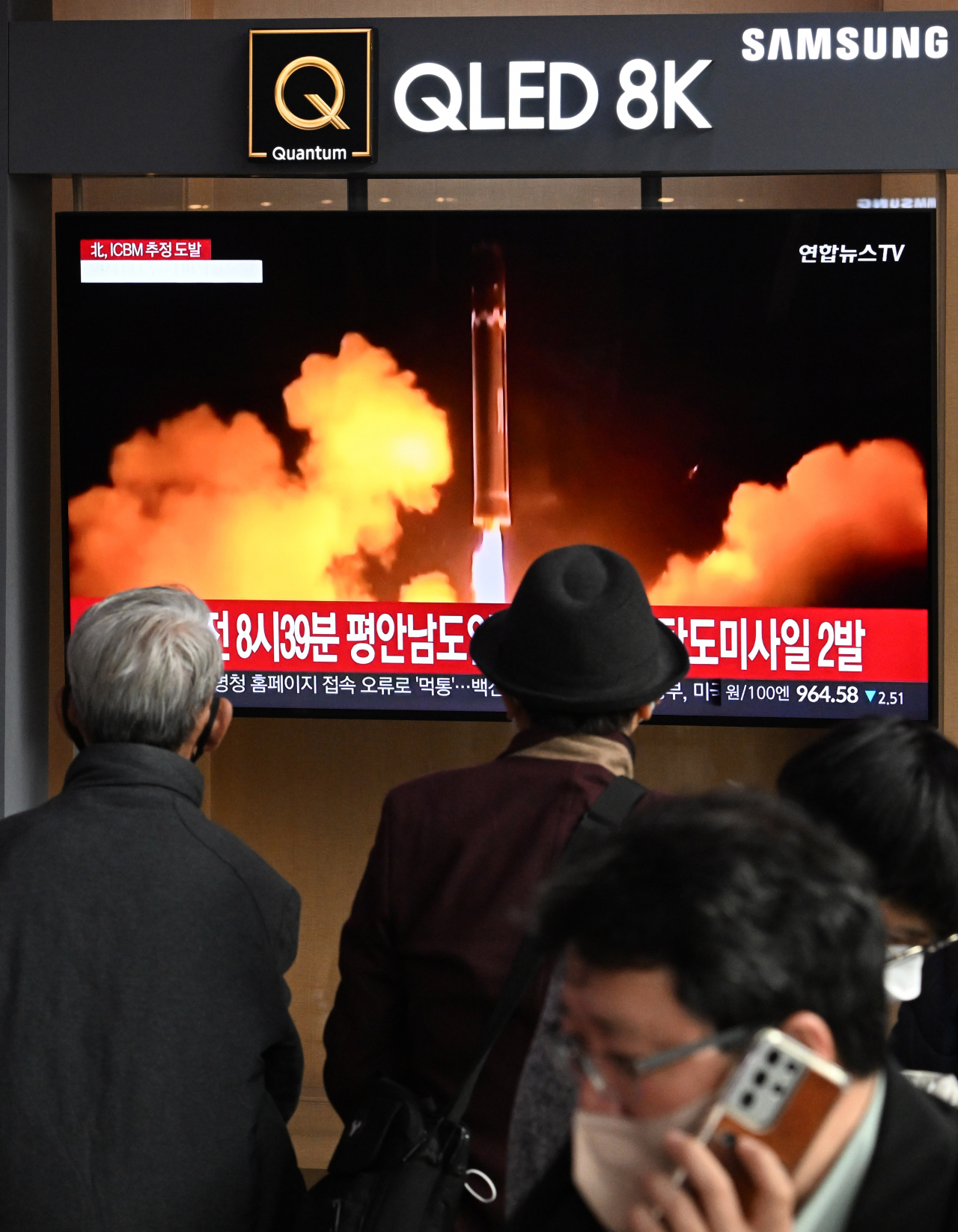N. Korea fires three missiles after denouncing US, S. Korea for extending aerial drills
US Air Force to dispatch B-1B Lancer bomber to S.Korea
By Ji Da-gyumPublished : Nov. 3, 2022 - 23:35

North Korea fired three more short-range ballistic missiles Thursday night, after a top North Korean military official denounced South Korea and the US for extending the “Vigilant Storm” air combat exercise.
The South Korean military detected three short-range ballistic missiles being fired from the area of Koksan County in North Hwanghae Province toward the East Sea from 9:35 p.m. to 9:49 p.m., according to the Joint Chiefs of Staff.
The short-range ballistic missiles traveled about 490 kilometers at a speed of Mach 6 and an altitude of 130 km, the JCS said in a statement, adding that South Korean and US intelligence authorities are analyzing the specifications.
“Our military will maintain a firm readiness posture while tracking and monitoring related moves in preparation for further provocations by North Korea in close coordination with the US,” the JCS said.
The South Korean military also detected around 80 artillery shots being fired from Kumgang County in Kangwon Province off the east coast from 11:28 p.m. on Thursday.
The artillery shots fell inside the inter-Korean maritime buffer zone, but north of the Northern Limit Line. The two Koreas agreed to cease all live-fire and maritime maneuver exercises in the buffer zones in a military tension reduction deal signed during the inter-Korean summit on Sept. 19, 2018.
The South Korean government said the artillery firing violated the Sept. 19 Comprehensive Military Agreement.
In addition, the South Korean military scrambled military aircraft, including F-35A fighter jets, on Friday after detecting North Korean military aircraft flying near a tactical action line.
The South Korean military spotted about 180 flight trails from 11 a.m. to 3 p.m., the JCS said, without providing further details including the number of North Korean planes involved in a formation flight.
North Korean warplanes were detected flying in multiple inland areas and along the country’s eastern and western coasts.
A series of military actions came after Pak Jong-chon, who serves as vice chairman of the Central Military Commission of the Workers’ Party of Korea, slammed South Korea and the US for deciding to extend the Vigilant Storm combined military exercise in a press statement.
Pak denounced the joint move by the allies as a “very dangerous and false choice,” alluding to further provocations by North Korea.
“The irresponsible decision of the US and South Korea is shoving the present situation caused by provocative military acts of the allied forces to an uncontrollable phase,” he said in an English-language statement issued by the Korean Central News Agency. “The US and South Korea will get to know what an irrevocable and awful mistake they made.”
The allies made the decision to extend the combined aerial drills on Thursday in response to the recent continuous provocations by North Korea.
The US Defense Department on Thursday confirmed that the combined air exercise has currently been extended to Saturday.
“We remain in close coordination with our ROK ally on any additional changes and the security environment on the Korean Peninsula. Our commitment to the defense of the ROK is ironclad,” Pentagon spokesman Lieutenant Colonel Martin Meiners said in a statement.
North Korea fired one intercontinental ballistic missile and two short-range ballistic missiles off the east coast on Thursday morning. Pyongyang also fired 25 missiles and around 100 artillery shells over the course of approximately 11 hours on Wednesday.
South Korea’s Air Force explained that such action was necessary to “demonstrate the solid combined defense posture of the ROK-US alliance under the current security crisis, which is heightened by North Korean provocations,” using an abbreviation for South Korea’s official name.
The US Air Force will reportedly dispatch a B-1B Lancer bomber from Andersen Air Force Base on Guam in the Western Pacific to the Korean Peninsula on Saturday.
A B-1B Lancer bomber will participate in the Vigilant Storm exercise. The US Air Force’s B-1 Lancer is a supersonic heavy bomber that can fly anywhere in the world within 24 hours.
South Korea and the US on Monday began conducting the five-day, large-scale Vigilant Storm aerial combat exercise to enhance combat readiness and train for wartime contingencies, amid mounting threats from North Korea.
An informed military source, who wished to remain anonymous, said South Korean Defense Minister Lee Jong-sup directly made the extension proposal to the US side during a banquet with US Defense Secretary Lloyd Austin in the run-up to their annual bilateral security talks.
The proposal followed President Yoon Suk-yeol's directive to take additional steps in response to the missile launch on Thursday morning.
North Korea has taken a series of escalatory steps at a sensitive time.
The South Korean and US defense chiefs met for their annual security talks on Thursday in Washington and discussed ways to enhance the alliance’s deterrence and readiness against escalating North Korean threats.
In addition, South Korea has been in a weeklong national mourning period for the victims of Saturday night’s crowd surge disaster in Itaewon, Seoul.







![[KH Explains] How should Korea adjust its trade defenses against Chinese EVs?](http://res.heraldm.com/phpwas/restmb_idxmake.php?idx=644&simg=/content/image/2024/04/15/20240415050562_0.jpg&u=20240415144419)











![[Today’s K-pop] Stray Kids to return soon: report](http://res.heraldm.com/phpwas/restmb_idxmake.php?idx=642&simg=/content/image/2024/04/16/20240416050713_0.jpg&u=)